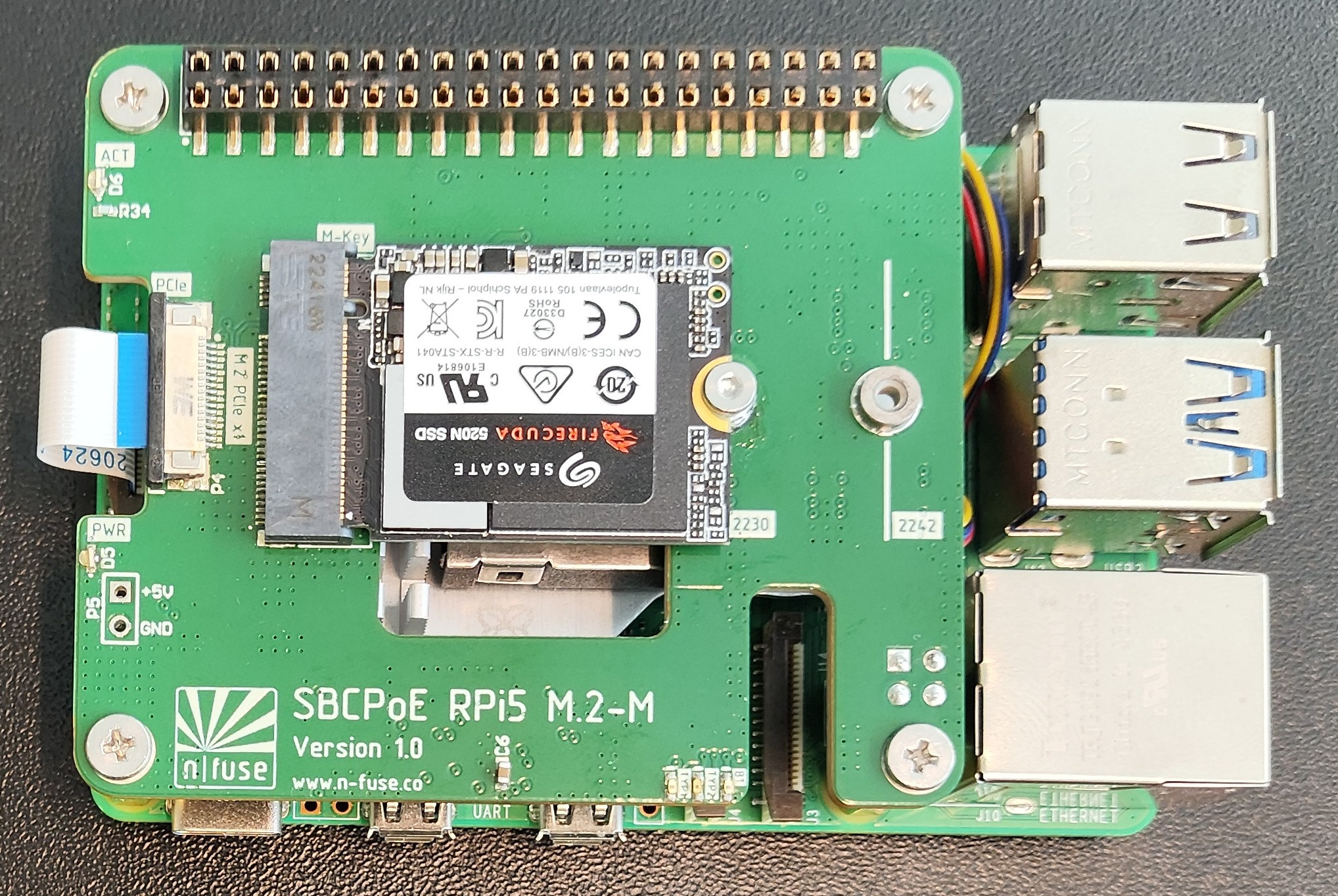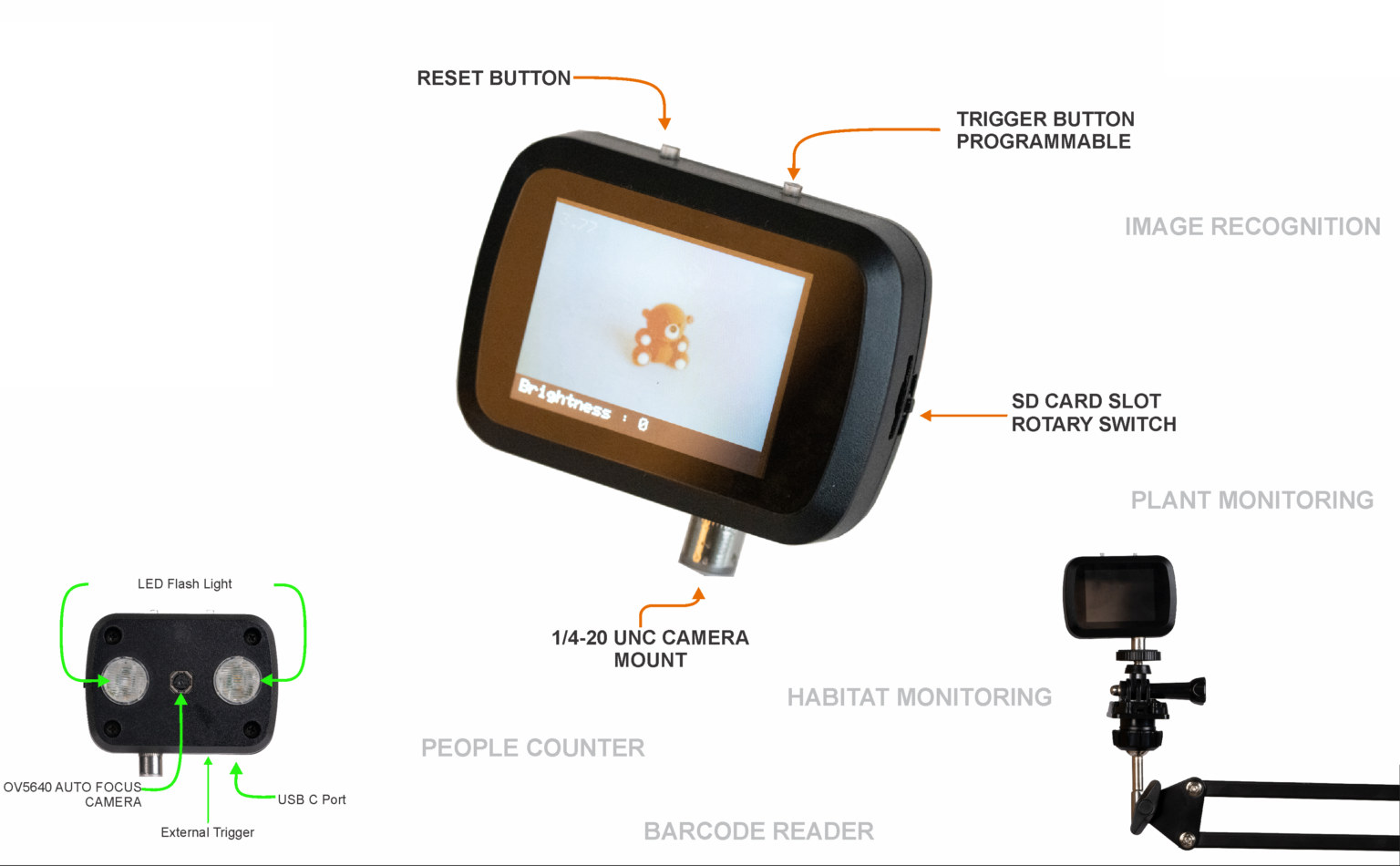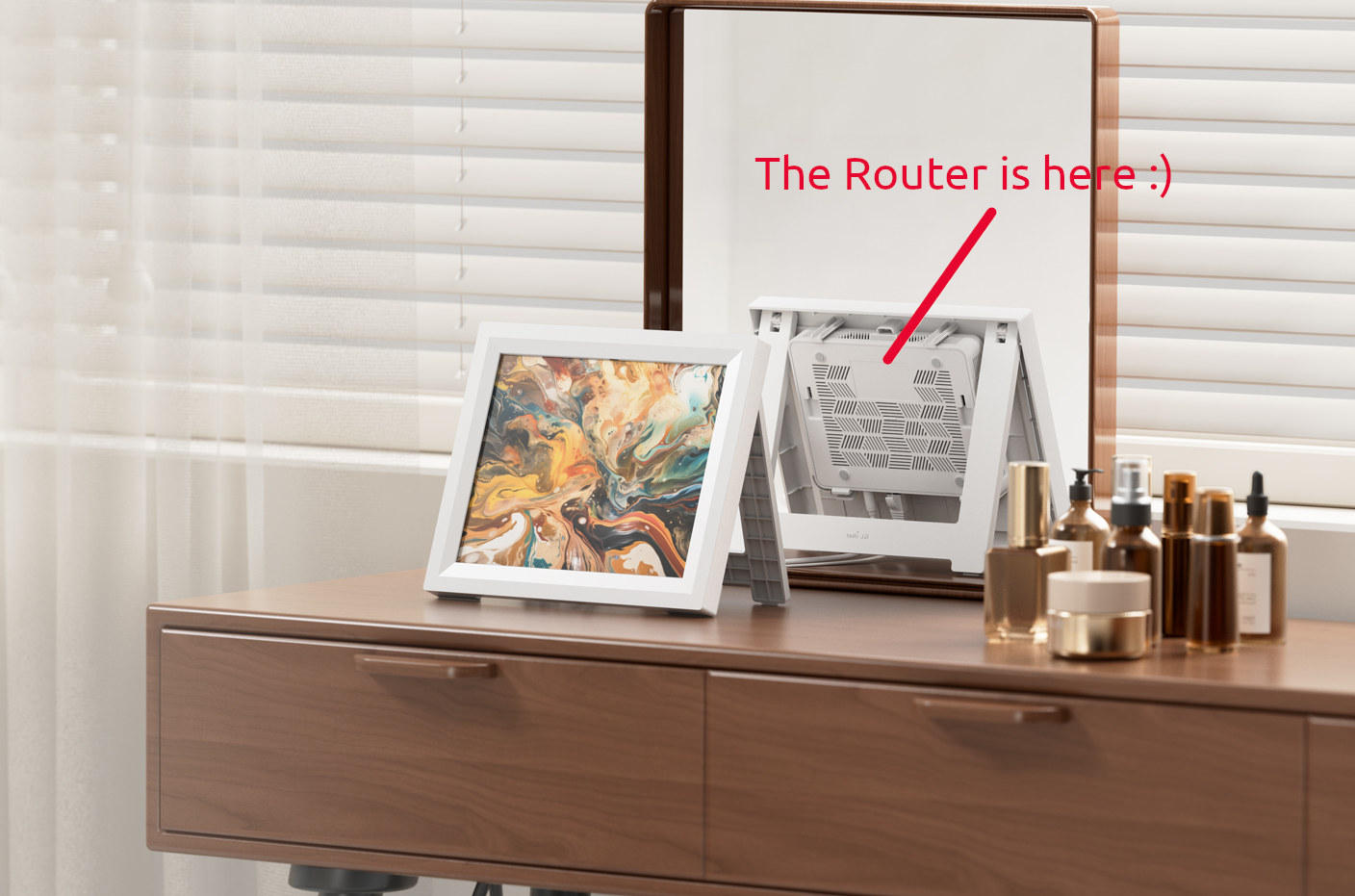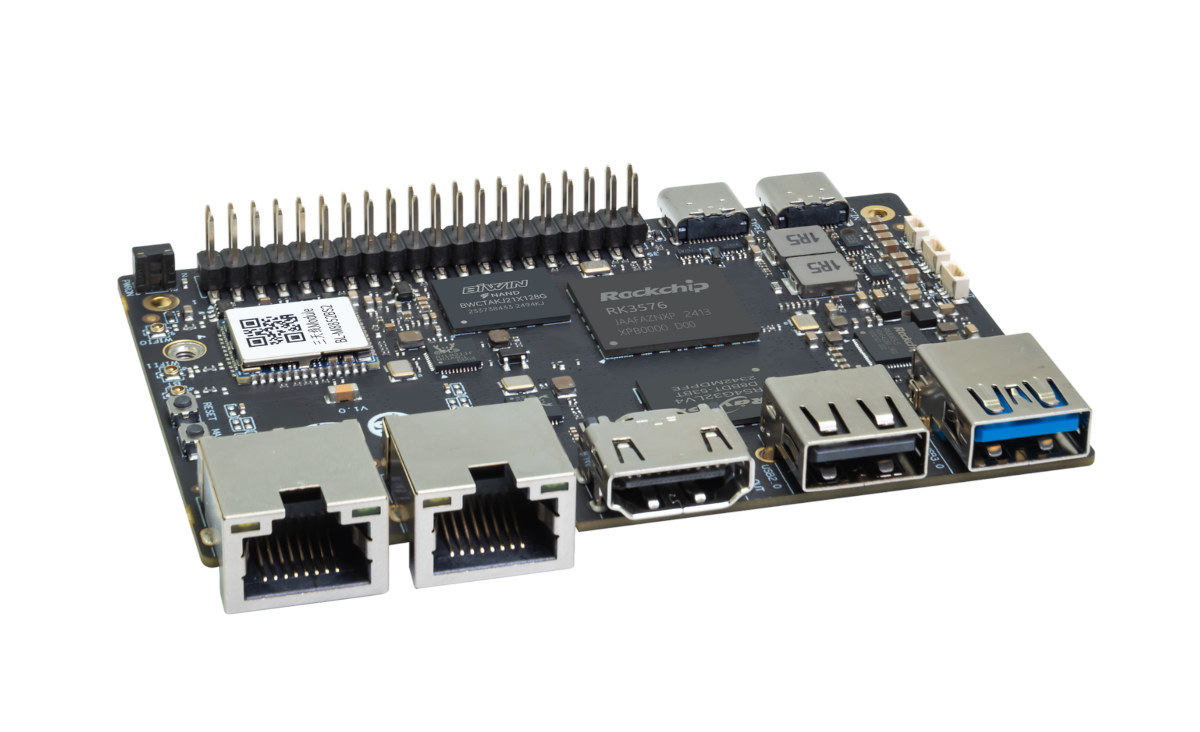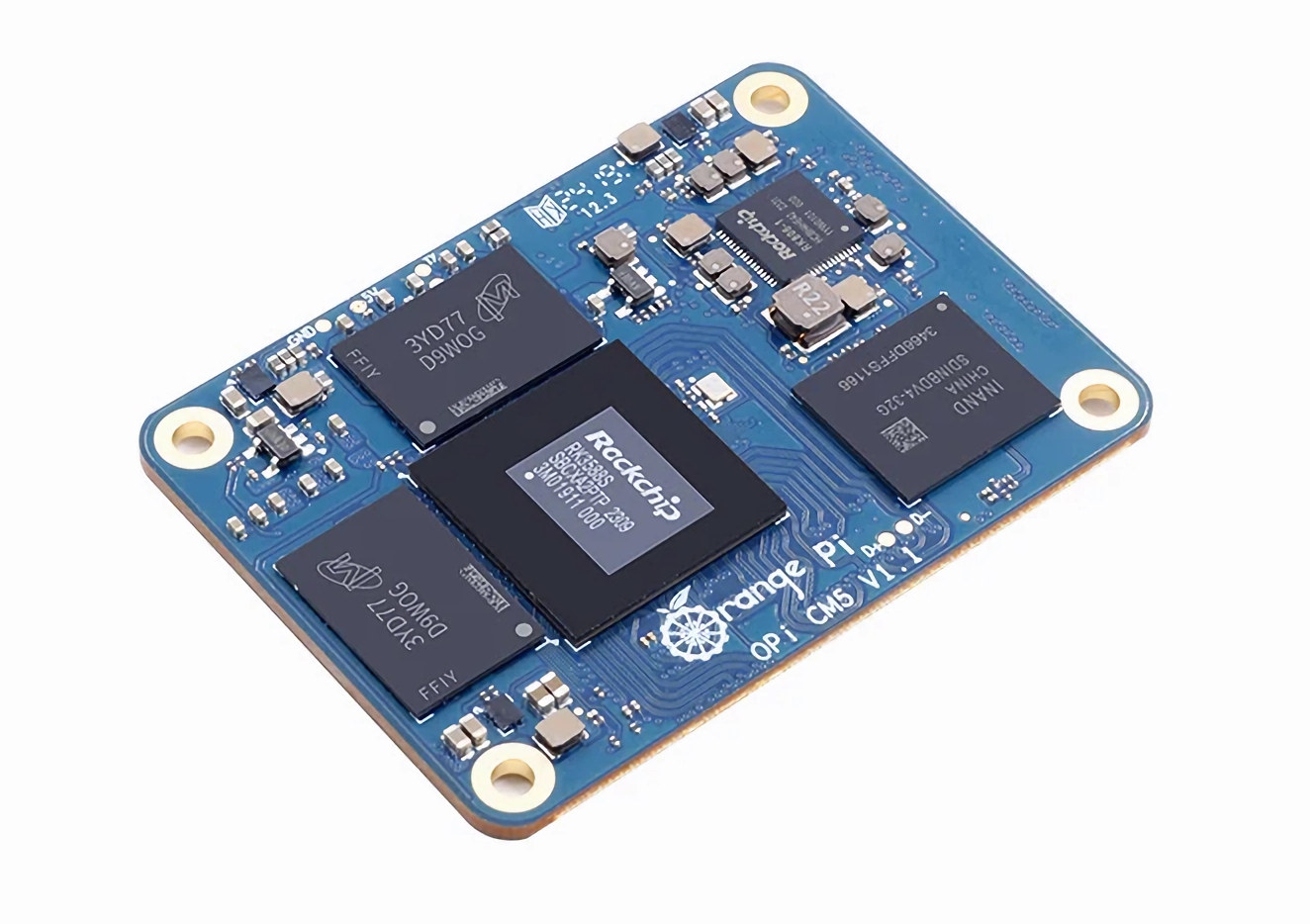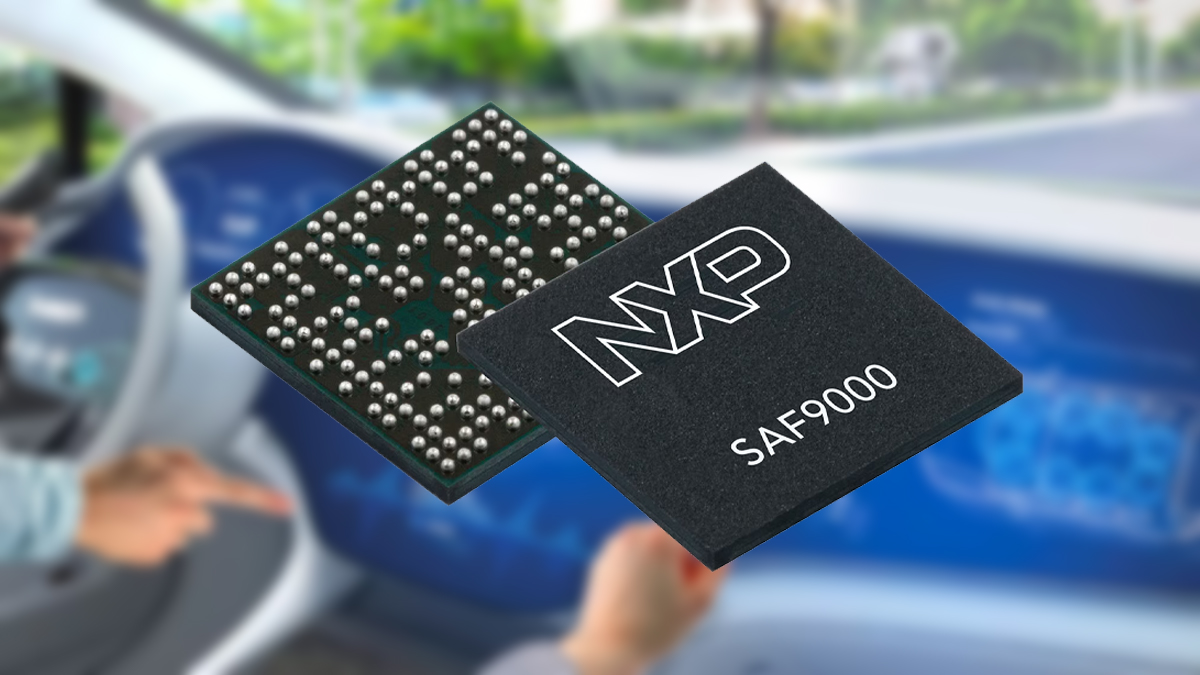N-Fuse has designed a PoE HAT for the Raspberry Pi 5 SBC that also serves as a PCIe expansion board thanks to either a mini PCIe socket or an M.2 Key-M, Key-B, or Key-E socket supporting 2230, 2242, or 3042 modules such as SSDs, AI accelerators, or wireless modules. The SBCPoE RPi5 HAT complies with the latest 802.3bt standard delivering up to 25W with active cooling or 15W with passive cooling. The HAT board still allows users to make use of the 40-pin Raspberry Pi 5 header thanks to a 40-pin Raspberry Pi interposition header. SBCPoE RPi5 HAT specifications: Power Supply IEEE 802.3af/at/bt compliant Overload protection 25W power delivery with active cooling, 15W without active cooling Output current up to 5A 5V output via optional 2.54mm pin header High efficiency (> 85%) enabled by active MOSFET bridge rectifier Short-Circuit Duration – infinity PCIe expansion (one or the other) Mini PCIe […]
NORVI AI Optic is an ESP32-S3 autofocus camera with dual LED flashlight, 2.1-inch LCD display
NORVI Controllers’ AI Optic – also written as AIOptic – is an ESP32-S3 camera solution with a 5MP OV5640 autofocus camera module, a 2.1-inch LCD Display, a dual LED flashlight, and a microSD card for data storage. The camera also features a USB-C port for power and programming and a built-in 600mAh backup battery. It comes with a rotary switch for menu navigation and power on/off and supports external triggers via a dry contact input. NORVI AI Optic specifications: Wireless module – ESP32-S3-WROOM-1U-N16R8 MCU – ESP32-S3 dual-core Tensilica LX7 up to 240 MHz with vector extension (for ML/AI), 512KB SRAM Memory – 8MB PSRAM Storage – 16MB flash Wireless – WiFi 4 and Bluetooth LE 5 Storage – MicroSD card slot Display – Optional 2.1-inch LCD display with 320×240 resolution using ST7789 driver Camera – 5MP OV5640 autofocus camera USB – 1x USB Type-C port for power and programming Misc Dual […]
GL.iNet GL-B3000 “Marble” WiFi 6 router ships with a photo frame
GL.iNet GL-B3000 “Marble” is a typical WiFi 6 AX6000 router that ships with a photo frame acting as a stand for the router and makes it look like an office or home decoration item rather than another bland white box on the desk. The Marble router is powered by a Qualcomm IPQ5018 dual-core Cortex-A53 networking SoC coupled with 512MB RAM and 128MB NAND flash. Like other GL.iNet routers, it runs an OpenWrt fork with GL.iNet Admin Panel, OpenVPN and Wireguard VPN client/server support, Adguard Home, parental control, and other features. GL.iNet GL-B3000 specifications: SoC – Qualcomm IPQ5018 dual-core Cortex-A53 processor @ 1 GHz System Memory – 512MB DDR3L Storage – 128MB NAND flash Networking 1x Gigabit Ethernet WAN port 2x Gigabit Ethernet LAN ports Dual-band IEEE 802.11a/b/g/n/ac/ax WiFi 6 up to 574Mbps (2.4GHz) and 2402Mbps (5GHz) 4x internal antennas Misc – Reset button Power Supply – 12V/1.5A DC Input via […]
MSI MS-C918 is a palm-sized pocket PC with Intel Processor N100 CPU, Windows 11 IoT Enterprise
MSI MS-C918 industrial palm-sized pocket PC is powered by an Intel Processor N100 CPU with up to 4GB LPDDR5 memory and a 128GB eMMC flash preloaded with Windows 11 IoT Enterprise. The mini PC also comes with two HDMI 2.0 ports including one with HDMI CEC support, gigabit Ethernet, WiFI 6E, and Bluetooth 5.2 connectivity, and three USB 3.2/2.0 ports. The company says it’s best suited for small office environments, digital signage, meeting systems, and other compact setups. MSI MS-C918 specifications: SoC – Intel Processor N100 Alder Lake-N quad-core processor @ up to 3.4 GHz (Turbo) with 6MB cache, 24 EU Intel HD graphics @ up to 750 MHz; TDP: 6W System Memory – Up to 4GB LPDDR5 @ 4800 MHz Storage 128GB eMMC flash MicroSD card slot Video Output – 2x HDMI 2.0 ports up to 4Kp60 with one supporting HDMI CEC Power On/Off Audio – 3.5mm audio jack, […]
Banana Pi BPI-M5 Pro low-profile SBC features Rockchip RK3576 octa-core Cortex-A72/A53 AIoT SoC
Banana Pi BPI-M5 Pro, also known as Armsom Sige5, is a low-profile single board computer (SBC) powered by the Rockchip RK3576 octa-core Cortex-A72/A53 SoC for the AIoT market that offers a mid-range offering between Rockchip RK3588 and RK3399 SoCs. The board comes with 16GB LPDDR4X and 128GB eMMC flash by default, offers dual GbE, WiFi 6 and Bluetooth 5.2 connectivity, an M.2 2280 PCIe socket for expansion, HDMI and MIPI DSI display interfaces, two MIPI CSI camera interfaces, a few USB ports, and a 40-pin GPIO header. Banana Pi BPI-M5 Pro specifications: SoC – Rockchip RK3576 CPU 4x Cortex-A72 cores @ 2.2GHz, four Cortex-A53 cores @ 1.8GHz Arm Cortex-M0 MCU at 400MHz GPU – ARM Mali-G52 MC3 GPU with support for OpenGL ES 1.1, 2.0, and 3.2, OpenCL up to 2.0, and Vulkan 1.1 NPU – 6 TOPS (INT8) AI accelerator with support for INT4/INT8/INT16/BF16/TF32 mixed operations. VPU Video Decoder: […]
Orange Pi CM5 – A Raspberry Pi CM4 alternative with up to 16GB RAM, 256GB eMMC flash
Orange Pi CM5 is a system-on-module mostly compatible with the Raspberry Pi CM4 (and upcoming Raspberry Pi CM5?) powered by a Rockchip RK3588S octa-core Cortex-A76/A55 processor that supports up to 16GB LPDDR4 and 256GB eMMC flash compared to the Pi CM4 module that is limited to 8GB RAM and 32GB flash. Since the Rockchip RK3588S has more interfaces than the Broadcom BCM2711 found in the Raspberry Pi CM4, the company added an extra 100-pin board-to-board connector with extra interfaces such as native USB 3.0, SATA III, CAN Bus, and an additional PCIe 2.0 x1 interface for a total of two. Orange Pi CM5 Orange Pi CM5 specifications: SoC – Rockchip RK3588S octa-core processor with 4x CortexA76 cores @ up to 2.4GHz, 4x CortexA55 core @ 1.8GHz Arm Mali-G610 MP4 “Odin” GPU with support for OpenGL ES1.1/2.0/3.2, OpenCL 2.2 and Vulkan 1.2 Video decoder – 8Kp60 H.265, VP9, AVS2, 8Kp30 H.264 […]
PCBWay’s 10th anniversary event – Win coupon codes worth up to $249 and various prizes (Sponsored)
PCBWay, one of the most popular PCB manufacturers around the world, is now almost 10 years old, and the company has started a promotional event for the PCBWay’s 10th anniversary with discount coupon codes, free boards, modules, tools, or kits, charity sales, and more. To get started, go to the 10th anniversary page, and click Enter to log in with your existing credentials or sign up for a new account with your email address. If you are a new user, you’ll also receive a welcome email with a special $5 coupon offer for 10 pieces of an up to 2 layer board and a $29 special offer for 1-20 pcs assembly following a long-term price reduction to celebrate the company’s 10th anniversary. After a customized welcome message, you’ll get access to a range of coupon codes to get discounts from $5 up to $240 for your next PCB order or even […]
NXP SAF9000 and SAF9100 Automotive Audio DSP bring AI to car infotainment
NXP has recently launched the SAF9xxx Automotive Audio DSP family, which currently includes SAF9000 and SAF9100 AI audio DSPs. Built around Cadence’s latest generation high-performance Tensilica HiFi 5 DSPs, these new chips not only feature AI and ML capabilities, but also include features like driver’s voice pitches and accent recognition, noise cancellation, voice recognition, emergency siren detection, and more. Additionally, the SAF9000 chip includes a software-defined radio option with up to five integrated tuners (controlled by an integrated Arm Cortex-M7 core) that covers all major global broadcast radio standards, including DAB, HD Radio, DRM, CDR, and AM/FM into a single chip solution. SAF9xxx Automotive Audio DSP specifications DSP – Tensilica HiFi 5 DSPs with dedicated neural network engines Integrated Controller – Arm Cortex-M7 core for tuner and audio control middleware Radio Features (SAF9000 only) Supports AM, FM, DAB, DAB+, DMB, HD Radio, DRM for AM, DRM for FM (DRM+), CDR […]


